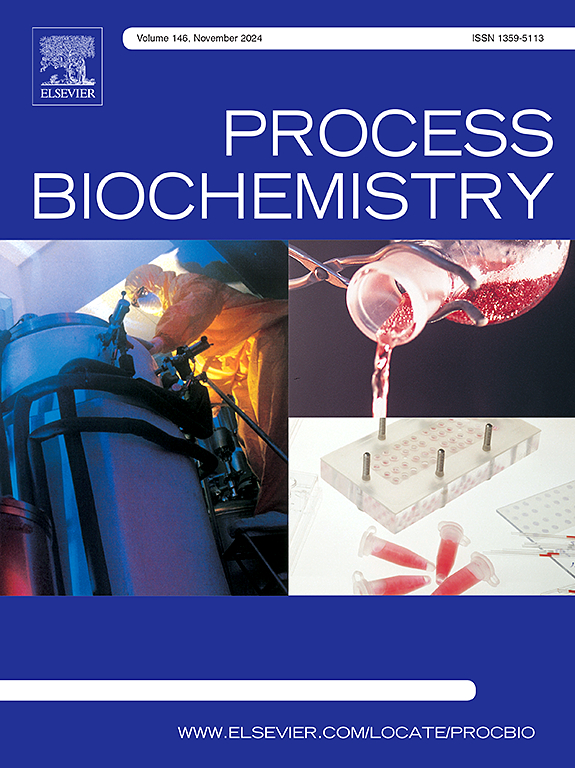Bioconversion of snakeskin shed into bioactive hydrolysate possessing antioxidant and cell proliferative potential
IF 3.7
3区 生物学
Q2 BIOCHEMISTRY & MOLECULAR BIOLOGY
引用次数: 0
Abstract
The underutilization of keratin-rich snakeskin shed (SS) to produce bioactive hydrolysate has not been explored to prevent oxidative stress, limiting its potential in biomedical and nutritional applications. This study aims to generate SS hydrolysate (SSH) through SS degradation using a keratinase-producing Bacillus altitudinis VK-1120. The contents of protein and amino acid of SSH were 13.93 ± 0.48 and 5.57 ± 0.06 mg/mL, respectively, after 96 h. Morphological and chemical changes before and after bacterial degradation were analysed. The SSH contained 16 amino acids, including eight essential amino acids, and demonstrated significant antioxidant activity, with a maximum efficacy of 4.16 ± 0.03 μg/mL for 2,2-diphenyl-1-picrylhydrazyl and 1319.53 ± 8.32 μg/mL for hydroxyl radical scavenging activity, equivalent to L-ascorbic acid. Furthermore, Fe2+- chelation and ferric-reducing antioxidant power were found to be 581.33 ± 3.33 μg/mL of EDTA-Na2 and 193.4 ± 5.83 μM of ferrous (II) sulphate equivalent, respectively. Cell viability and migration analysis showcased the proliferation of fibroblast cells with 50, 200, and 500 ng/mL of SSH at 24 h and a reduction in wound area with increasing SSH concentration. Therefore, SS could be utilized as a bioresource for producing both keratinase and antioxidant-rich hydrolysate for identifying biologically active molecules.
蛇皮蜕皮转化为具有抗氧化和细胞增殖潜能的生物活性水解产物
富含角蛋白的蛇皮皮(SS)在生产生物活性水解物以防止氧化应激方面的利用不足,限制了其在生物医学和营养方面的应用潜力。本研究旨在利用产角化酶的高山芽孢杆菌VK-1120降解SS,生成SS水解物(SSH)。96 h后,SSH蛋白和氨基酸含量分别为13.93±0.48和5.57±0.06 mg/mL。分析了细菌降解前后的形态和化学变化。SSH含有16种氨基酸,其中8种必需氨基酸,具有显著的抗氧化活性,对2,2-二苯基-1-苦酰肼的清除活性最高为4.16±0.03 μg/mL,对羟基自由基的清除活性最高为1319.53±8.32 μg/mL,相当于l-抗坏血酸。EDTA-Na2的螯合能力和还原铁的抗氧化能力分别为581.33±3.33 μg/mL和193.4±5.83 μM的硫酸亚铁当量。细胞活力和迁移分析显示,在24 h时,50、200和500 ng/mL的SSH可使成纤维细胞增殖,伤口面积随着SSH浓度的增加而减少。因此,SS可以作为一种生物资源,用于生产角化酶和富含抗氧化剂的水解产物,以鉴定生物活性分子。
本文章由计算机程序翻译,如有差异,请以英文原文为准。
求助全文
约1分钟内获得全文
求助全文
来源期刊

Process Biochemistry
生物-工程:化工
CiteScore
8.30
自引率
4.50%
发文量
374
审稿时长
53 days
期刊介绍:
Process Biochemistry is an application-orientated research journal devoted to reporting advances with originality and novelty, in the science and technology of the processes involving bioactive molecules and living organisms. These processes concern the production of useful metabolites or materials, or the removal of toxic compounds using tools and methods of current biology and engineering. Its main areas of interest include novel bioprocesses and enabling technologies (such as nanobiotechnology, tissue engineering, directed evolution, metabolic engineering, systems biology, and synthetic biology) applicable in food (nutraceutical), healthcare (medical, pharmaceutical, cosmetic), energy (biofuels), environmental, and biorefinery industries and their underlying biological and engineering principles.
 求助内容:
求助内容: 应助结果提醒方式:
应助结果提醒方式:


